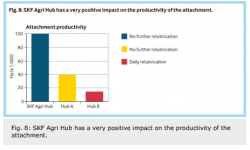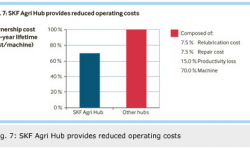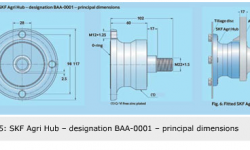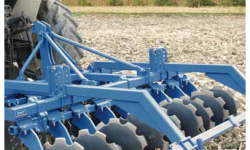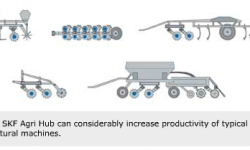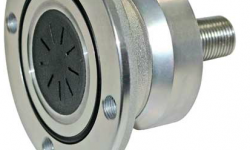
Increasing the performance of soil cultivation machines with SKF Agri Hub
SKF Agri Hub, an extremely robust unit for independent tillage discs, is developed to meet demands from the agriculture industry for increased productivity, cost reduction and conservative care of the environment.
SKF Agri Hub, an extremely robust unit for independent tillage discs, is developed to meet demands from the agriculture industry for increased productivity, cost reduction and conservative care of the environment.
As efficient soilcultivation is at the heart of agricultural production, SKF is helping farmers increase their productivity by developing solutions for disc harrows with independent discs. These are now the mainstay of soil management, due to the introduction of the minimum tillage process in farm industry.
Minimum tillage, a new conservative cultivation process
Soil cultivation (or tillage) is the first step of the agriculture process. The machines used for this purpose include harrows, rippers, cultivators and ploughs. One of the main challenges in modern agriculture is to avoid soil erosion by making sure that mechanical tillage processes are carried out effectively and the essential ecological systems that support good crop-growing conditions are preserved. In this regard, conservative cultivation (minimum tillage) of the basic soil means providing the flattest possible cultivation with a low soil penetration. This enables the harvest residues to stay on the surface soil and be integrated into the upper soil layer. The higher the coverage of the soil with plant residues, the higher is the resistance to soil erosion. This helps to sustain soil fertility, protect the environment and increase the profitability of the agricultural production.
New process needs new disc harrow techniques
Due to this new agriculture process (min-imum tillage), new agricultural implements have been introduced to the market by the main attachments manufacturers. The technology of gang disc harrows is often replaced by the new independent disc harrow machines. In Europe today, there are more independent disc harrows than gang disc machines, whereas in the Americas the gang disc technology is still predominant.
What’s the difference between gang and independent discs?
There are basically two types of disc suspensions for disc harrows. In one instance several or all the discs are mounted on a single ridged shaft; in the other the discs are mounted on a disc framework, called the “gang disc.” The single disc suspension has the distinct advantage of increased performance – speed, flexibility, stability, robustness and reliability – compared with the serial mounting. The soil turnover is more consistent and with better soil mixing. For conser-vative soil cultivation, disc harrows loosen the soil and prepare the seedbed. Furthermore, with mulch sowing, the discs enable an excellent distribution and integration of stubble, straw and plant residues into the ground.
The most important argument for an agricultural farm is probably cost-
effectiveness: Disc harrows with independent suspension enable a significantly higher working speed (up to 20 km/h), considerably reducing the time needed for soil cultivation (up to three times compared with previous gang disc technology).
New disc harrows techniques create the need for a new bearing solution
Independent disc suspension makes new demands on bearing solutions.The independent suspension needs a unit:
-
That is able to support the disc independently and react to tilting forces coming from the earth and acting on the disc;
-
That is effective against contaminants, such as strings, mud and dust, fertilizer, stones, water, snow, jet cleaning, that can damage a sealing system; and
- That enables the disc to rotate for a better tillage operation.
SKF’s answer to this new need is a unitized solution, SKF Agri Hub (fig. 1), that integrates a flange function link to the disc, a bearing enabling rotation, an efficient sealing system to keep out contaminants and a stub axle to link to the arm.
Agricultural machine manufacturers need to design their machines to meet the rough conditions they are likely to encounter. SKF has a long tradition of supplying products and solutions for agricultural machines. The latest addition is SKF Agri Hub, which is developed to considerably increase the prod-uctivity of harrows with independent discs as well as of machines such as mould ploughs, rippers, disc cultivators, stubble cultivators and combined tillage planters (fig. 2).
SKF Agri Hub a proven solution to increase productivity
Designed for the independent suspension discs (fig. 3), SKF Agri Hub is fitted with a special seal that has been successfully tested under extreme mud and dust conditions. Even under weather conditions of -20 °C on a Russian farm, SKF Agri Hub functioned faultlessly. This is proven by the results of SKF Agri Hub delivered from series production. They succesfully passed the first tillage season in Russia without any performance problems.
Cost-effective and environmentally friendly
Most conventional solutions for disc harrows, where the discs are mounted independently, have a lubrication nipple fitted on each disc to relubricate the bearings. Very frequent relubrication is required, often daily, because the disc harrow loses lubricant. This lubricant loss is most likely the result of the seal not being able to withstand the tough operating conditions. Furthermore, farmers relubricate to make sure that all contaminants, such as sand, dust and dirt, are purged from the hub by pumping in fresh grease until it pops out of the hub. An undesirable side effect of this operation is grease leakage into the soil. Experience shows that this burdens the soil by as much as 500 kg of lubricant per machine per 10 years of ground cultivation. (fig. 4). Additionally, re-greasing is a time-consuming and costly task for the disc harrow user. Cleaning the soiled nipples, washing and re-greasing a 3-metre-wide disc harrow with 20 hubs takes on average 1/2 hour per day per machine.
By contrast, SKF Agri Hub offers lifelong lubrication. The hermetic sealing makes sure that no lubricant loss can occur over the complete life span of this plug-and-play unit. Central to the sealing principle is the “mud block” seal and the special labyrinth, which has already been in use by SKF in applications where an absolutely tight seal is required and provides the dynamic sealing against stones, mud and any kind of dust. Examples of these are building machines such as shovel excavators or tractors and other agricultural machines. A special cup and O-ring system provides the static sealing of the disc side in the SKF Agri Hub unit, rendering it impervious to snow, water or mud.
Robust design, easy to install and replace
The outstanding characteristics of SKF Agri Hub mean that it is virtually maintenance-free and is extremely reliable in operation. During the design phase, particular attention was paid to the simple handling and robust construction. The unit is mounted onto the disc frame by a 28 mm shaft and is affixed by a M22 nut to the framework (figs. 5 and 6). The discs are screwed to the SKF Agri Hub unit by four M12 screws, which enable distortion-free mounting of the discs. The axial and radial shock impacts incurred during use are absorbed by a double row angular contact ball bearing. To combat the unavoidable dirty conditions during field cultivation, the surface of SKF Agri Hub is coated with an ecologically compatible zinc layer that enables a relatively light cleaning of the units with a high-pressure hose. The specially designed surface geometry prevents grasses, stems or roots from becoming entangled in SKF Agri Hub.
SKF Agri Hub has a key role in the improvement of agricultural machinery. In use, it provides farmers with higher prod-uctivity and cost reduction. For manufacturers of soil cultivating machines, the benefit of adapting these units is twofold. Firstly, they have access to a high-quality mechanical component, which adds value to their products. Secondly, SKF Agri Hub reduces production costs.
In addition, SKF Agri Hub makes a posi-tive contribution to the environment by avoiding leakage of lubricant into the soil (fig. 4).
A farmer’s testimony
“My farm requires 40 days of tillage a year – 30 in spring to prepare for the maize and 10 in autumn to prepare for the wheat. With the new SKF solution there is no need to wash and lubricate the discs, and I save half an hour a day. The work is done more quickly and easily. We drive at more than
20 km/h and I have seen an improvement in the way the land is worked. The old 2.5-metre wide harrow had a top speed of 7 or 8 km/h and could work one hectare an hour. The new machine, which is also 2.5 metres wide, covers 2.5 hectares an hour. The old 20 disc harrow required a 20-kg can of grease each year, and with this new solution I’ve eliminated greasing and washing entirely. In my job I’m in contact with nature every day, and I’m pleased that with the new SKF solution I’m not polluting the land with grease anymore.”


